St. Jeanne d'Arc, France's national hero, was a peasant girl who led the French army in a historic victory at Orléans that prevented an English attempt to invade France during the Hundred Years' War. She believed she was operating under heavenly guidance. After being captured a year later, the English and French allies executed Joan as a heretic. Nevertheless, she rose to become the greatest national hero of her fellow citizens, and her achievement greatly influenced the subsequent resurgence of French nationalism.
Jeanne d'Arc was the daughter of a tenant farmer. She perceived the voices of St. Michael, St. Catherine of Alexandria and St. Margaret of Antioch who guided her in her quest to drive the English and their Burgundian allies from the Valois Empire in France. Joan had many qualities that were typical of the female visionaries that were a remarkable feature of her period, including extraordinary mental and physical courage, as well as a strong common sense. Extreme personal piety, direct contact with saints, and the resulting dependence on personal encounters with God's presence outside the official church area were some of these qualities.
Mission of Jeanne d'Arc Arc
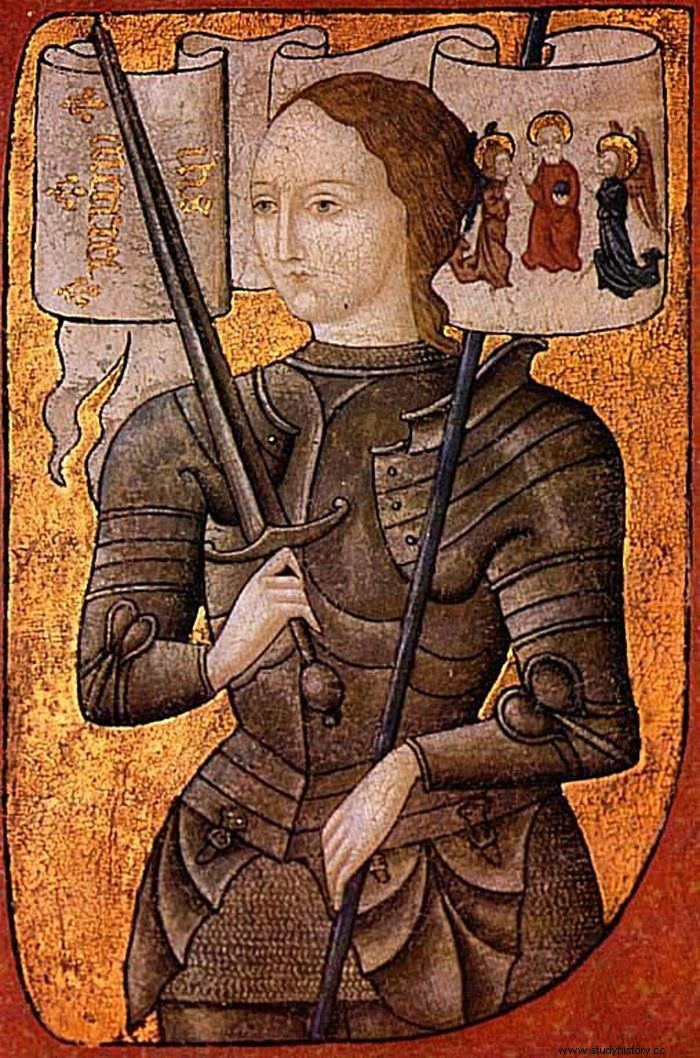
The Lancastrian English monarch Henry VI and the dauphin Charles, son and heir to Valois king Charles VI, disagreed on the French throne. Most of the northern part of the kingdom was under the control of Henry's soldiers, who were allied with Philip the Good, Duke of Burgundy. The Dauphin had still not been crowned five years after his father's death, which contributed to the apparent despair of the cause at the end of 1427. Reims, the common site of the inauguration of French monarchs, stood in the way of his opponents. The legitimacy of the dauphin's claim to be king of France can be disputed as long as he was an unmarried man.
Domrémy, where Jeanne d'Arc lived, was located on the border between the Dauphin's France and Anglo-Burgundy France. Before the Burgundian threats, the people had already been forced to leave their homes. Joan left Domrémy in May 1428 and traveled to Vaucouleurs, the nearest fortress still loyal to the Dauphin, led by the voices of the Saints. There she formally asked permission to join the dauphin from Robert de Baudricourt, the garrison captain. However, the 16-year-old went to a home since he did not take her dreams seriously. In January 1429, Joan returned to the Vaucouleurs.
This time the people respected her for her calm strength and piety, and the captain, convinced that she was not a witch or mentally debilitated, gave her permission to visit Dauphin in Chinon. She left Vaucouleurs around February 13 while wearing menswear and carrying six warriors. Finally, after 11 days of wandering across enemy territory, she arrived in Chinon.
Despite Charles' initial reluctance to accept her, Joan immediately traveled to his castle. He received mixed opinions from his advisers, but he offered her an audience two days later. Charles tried to mix with his courtiers as a test, but Joan quickly found him and informed him that she wanted to fight the English and wanted to crown him in Reims. Church officials asked her for the dauphin's instructions in the presence of Charles' relative Jean, Duc d'Alençon, who expressed good feelings for her. She was then sent to Poitiers for three weeks, where renowned theologians who supported the Dauphin's cause interrogated her further.
After the end of the Western schism in 1417, there was a constant fear of heresy. This led to these investigations, which have not survived. Joan assured the clergy that she would demonstrate the success of her mission in Orléans instead of Poitiers, and on March 22, she began dictating letters of defiance to the English. In their report, the churchmen recommended the dauphin to hire her given the serious circumstances in Orléans. Orleans had been under English siege for several months
Jeanne d'Arc returned to Chinon. Dauphinen gave her a military household in Tours in April, including brothers Jean and Pierre and Jean d'Aulon, who served as her owner. She had a banner made with Jesus' name and had her standard painted with a picture of Christ sitting and judging. She predicted that a sword would be found at the Church of Sainte-Catherine-de-Fierbois, and one was found there when the theme of a sword came up.
Action on Orléans
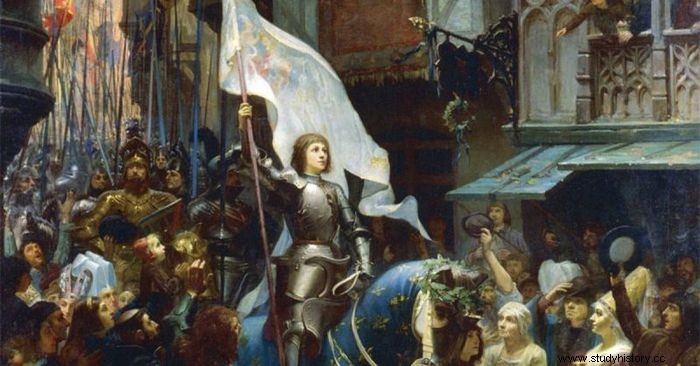
At Blois, several hundred French soldiers were mustered, and on April 27, 1429, they went to Orléans. A ring of English fortresses almost surrounded the city, which had been under siege since October 12, 1428. On April 29, when Joan and one of the French commanders, La Hire, arrived with supplies, she was informed that action had to be taken. exposed until more soldiers could come.
On the night of May 4, while Joan was asleep, she suddenly jumped up, apparently inspired, and declared that she had to go and attack the English. She quickly armed herself and traveled to an English fort east of the city, where she learned that an engagement had already begun. Her appearance aroused the French, who seized the fort. The next day, Jeanne d'Arc wrote a new letter to the English in spite. The English quickly withdrew to defend a stronger position nearby, but Joan and La Hire attacked them and seized it by storm. She crossed to the south bank of the river in early May 6 and moved to another fort.
The French attacked the fort at Les Tourelles very early on 7 May. The French leaders continued the attack until the English surrendered in part due to Joan, who was wounded but quickly returned to battle. The English were observed withdrawing the next day, but Joan forbade any persecution because it was a Sunday.
Victories and coronation
On May 9, Joan left Orleans and met Charles in Tours. To be crowned, she persuaded him to travel quickly to Reims. Although he was hesitant because some of his more sensible advisers encouraged him to take on the conquest of Normandy, Joan's insistent nature eventually won. However, it was determined to expel the English from the other towns along the Loire River first. So Joan and her friend, Duc d'Alençon, took a city and a significant bridge.
The English then fled inside the fortress after attacking Beaugency. Constable de Richemont, wanted by the French court, was then received by Joan against the opposition of the Dauphin and his adviser Georges de La Trémoille despite Alençon's reservation. She accepted his help after prompting him to pledge allegiance, and soon Beaugency Castle was abandoned.
On June 18, 1429, French and English forces collided at Patay. Joan assured the French that they would succeed, and predicted that Charles would surpass all his previous victories that day. But instead, the English army was overthrown, which ended in their reputation as invincible, and the triumph was absolute total.
Joan and the French commanders turned to reunite with the dauphin. The Dauphin lived at La Trémoille in the Sully-sur-Loire, instead of taking advantage of them by daring to attack Paris. Once again, Jeanne d'Arc pressured Charles to proceed quickly to Reims for his coronation. He hesitated, however, and Joan followed him as he meandered through the towns of the Loire Valley, trying to persuade him to act without delay despite the advice of his advisers. Although she was aware of the risks and challenges, she considered them unimportant, and eventually persuaded Charles to agree with her.
The Dauphin issued the usual summons letters to the coronation from Gien, where the army began to gather. Joan wrote two letters, one to the faithful pro-Charles citizens of Tournai and the other to Philip the Good, Duke of Burgundy, challenging him to a duel. On June 29, she and the dauphin set out on the march to Reims. Joan wrote to the locals before she arrived in Troyes, promising them forgiveness in exchange for submission. They responded by sending Brother Richard, a well-liked preacher, a monk, to assess her. The villagers chose to stick to the Anglo-Burgundian government, even though he returned full of enthusiasm for the Maid of Orléans and her mission.
The inhabitants easily agreed to the attack the next morning when the Dauphin's council decided that Joan should lead the attack on the city. After that, the royal army went on to Châlons. Here the Count-Bishop Charles gave the keys to the city despite his decision to resist. As a result, the city's gates were unlocked when the royal troops arrived in Reims on July 16. On July 17, 1429, the monarch was crowned. At the dedication, Joan was present and placed near the altar while holding her flag. After the ceremony, she bowed to Charles and addressed him as her monarch for the first time. She urged the Duke of Burgundy to make peace with the king and remove his garrisons from the royal fortresses in a letter sent to him the same day.
Ambitions for Paris
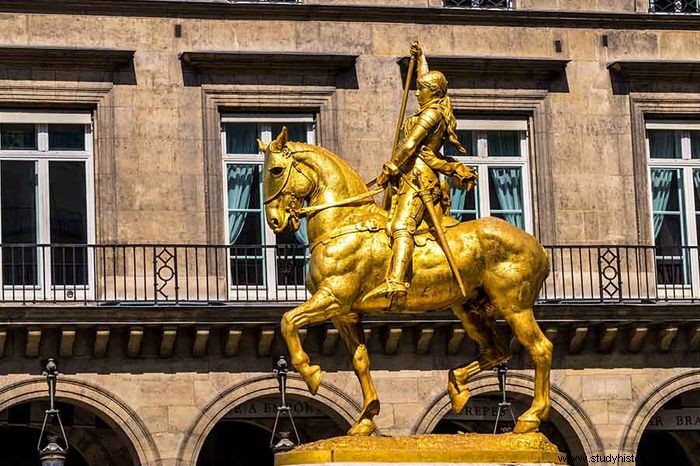
Troops marched through Champagne and Île-de-France for a month after Charles VII left Reims on July 20. The monarch chose to withdraw from the Province to the Loire on August 2, which meant that he gave up all plans to invade Paris. However, the caring communities that would have been left to the mercy of the intruder showed some concern. On August 5, Jeanne d'Arc, who disagreed with Charles' choice, wrote to assure the people of Reims that the Duke of Burgundy, then in control of Paris, had entered into a truce for fourteen days and that it was believed that he would surrender Paris. to the king after that.
To the delight of Joan and the commanders, who believed that Charles would attack Paris, English troops prevented the Royal Army from crossing the Seine at Bray on 6 August. A chronicler from the 15th century said that Joan had achieved worldwide recognition and was now the idol of the French people. She believed that the mission's goal had been achieved.
On August 14, the French and English soldiers collided once again near Senlis. This time, however, only skirmishes were fought; neither side dared to start a full-scale battle, although Joan boldly confronted the enemy by carrying her flag up to their earthworks. Meanwhile, the king received the surrenders of Compiègne, Beauvais, Senlis and other cities north of Paris. The Burgundians then agreed on a four-month ceasefire for the entire region north of the Seine on August 28.
On the other hand, Joan despaired and felt the need to travel to Paris. The Parisians began preparing their defenses while she and Alençon were in Saint-Denis on the northern outskirts of the city on 26 August. On September 8, a raid was made between the gates of Saint-Honoré and Saint-Denis after Charles' arrival on September 7.
Jeanne d'Arc stood up for the earthworks and urged the besieged inhabitants of Paris to hand over her city to the King of France, so that there could be no dispute about her presence among the sieges. She continued to inspire the soldiers while she was injured until she was forced to stop the attack. She and Alençon tried to restart the attack the next day, but Charles' council ordered them to withdraw.
Capture, Trial and Execution of Jeanne d'Arc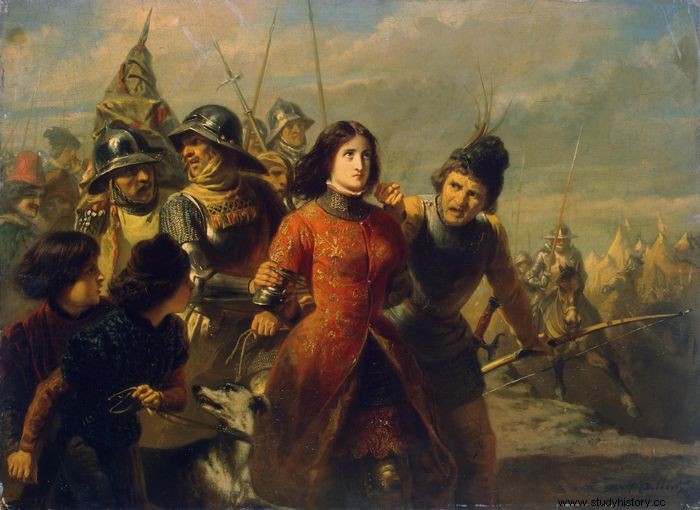
Joan was told that the city had been besieged while on her way back to Compiègne from John of Luxembourg, the captain of a Burgundian company. She moved quickly and snuck into Compiègne after nightfall. Joan started an outing the afternoon after, on May 23, and defeated the Burgundians twice, but she was eventually flanked by English reinforcements and forced to flee. She was on horseback and could not get up, so she stayed until the end to watch over the rear guard when they crossed the Oise River.
She surrendered and was sent to Marigny, where the Duke of Burgundy visited her with his brother Pierre and Jean d'Aulon. Renaud of Chartres accused Joan of ignoring all advice and action when he gave the news of her capture to the inhabitants of Reims. Charles did not try to save her because he negotiated a peace with the Duke of Burgundy.
Jeanne d'Arc and Jean d'Aulon were invited to the Palace of John of Luxembourg in Vermandois. He sent her to one of her more remote castles as she tried to flee to return to Compiègne. Although she received friendly treatment there, she was increasingly disturbed by Compiègne's situation. Eventually she became so desperate to escape that she jumped off a tower and fell unconscious into the moat. After recovering from the minor injuries, she was sent to Arras, a city that supported the Duke of Burgundy.
On May 25, 1430, the news of her capture had reached Paris. The theology department of the University of Paris, which had sided with England, demanded that the Duke of Burgundy send her to the Chief Inquisitor or to Bishop Pierre Cauchon of Beauvais, whose diocese she had been taken, for judgment the next day. The University also sent a letter to John of Luxembourg with the same request. Finally, on July 14, the Bishop of Beauvais appeared before the Duke of Burgundy. He requested that the maid be released in exchange for a payment of 10,000 XNUMX francs.
By January 3, 1431, she was in the bishop's custody when the duke forwarded the claim to John of Luxembourg. Rouen was chosen as the place of trial. The Earl of Warwick, the English commander in Rouen, lived in the Bouvreuil fortress. That was where Joan was transferred to a tower. Joan was indicted in a church court despite her well-known violations of the Lancastrian monarchy. This is because the theologians at the University of Paris, who serve as the final authority in matters of faith, insisted that she be tried as a heretic. According to the standards of orthodoxy established by many theologians at the time, her views were not strictly orthodox.
She posed a danger to the hierarchy of the church militant on earth (who is believed to be engaged in a spiritual battle against the forces of evil) by claiming that she had direct access to God through visions or voices. Her trial could also damage Charles VII's reputation by showing that he was crowned by a witch or at least a heretic. Cauchon, Bishop of Beauvais, and Jean Lemaître, French Vice-Inquisitor, were to serve as her two judges.
Trial
The bishop and his assessors began reading declarations collected in Lorraine and abroad January 13, 1431; they served as the setting for Joan's interrogation. When Joan received a summons to appear before her judges on February 21, she asked permission to attend the fair in advance. Nevertheless, it was denied because of the seriousness of the offenses she was charged with, including the suicide attempt she committed by jumping into the moat. She was required to promise to tell the truth, which she did, but consistently refused to reveal what she had said to Charles.
Jeanne d'Arc claimed that she was ethically free to try to escape Cauchon, who prevented her from leaving her confinement. She was then chained to a wooden block and occasionally placed in iron. Guards were responsible for being inside the cell with her at all times. She was questioned over a dozen times between February 21 and March 24. She was forced to swear again to tell the truth every time. Yet she always made it clear that she did not necessarily want to tell the judges everything because almost all of them were French. Besides, they were all King Charles' opponents. Finally, on March 24, she heard the results of this first interrogation read to her, and she confirmed the accuracy - except for two points.
It took Joan two days to respond to the 70 charges against her when the trial began a day later. These were primarily based on the argument that her actions demonstrated blasphemous conjecture:specifically that she claimed divine revelation as the source of her prophecies, predicted the future, signed her letters with the names of Jesus and Mary, and associated herself with the new and dubious. worship of Jesus' name, confessed assurance of salvation, and dressed as a man. However, the accusation that she preferred what she thought was God's direct command over the church's was perhaps the most damaging.
On March 31, she was asked again about several topics, including the surrender to the church, about which she had previously been evasive. In her situation, submission to the court that tried her was eventually put to the test. She tried her best to avoid falling into this trap, claiming that although she knew full well that the church militant could not be wrong, she held herself accountable to God and her saints for her words and deeds. Nevertheless, the trial continued, and the 70 claims were reduced to 12. They were forwarded to a number of eminent theologians in both Rouen and Paris for consideration.
While this was happening, two doctors approached Jeanne d'Arc while they were in prison. On April 18, Cauchon and his staff visited her and encouraged her to submit to the Church. Joan asked to be allowed to participate in the confession, take communion and be buried on the holy ground because she was extremely ill and thought she was about to die. On May 9, they were more relentless and threatened to torture her if she did not clarify further matters.
She replied that she would not change her answer even if they tortured her to death, and added that Joan would at least afterwards claim that any remark she could have made had been forced out of her. Her interrogators judged that torture would be ineffective by 10 to 3 in light of this common sense. On May 23, Joan was notified of the University of Paris' plan to hand her over to secular authorities if she continued to practice heresy because only they, not the church, could execute an undeclared heretic.
Execution of Jeanne d'Arc
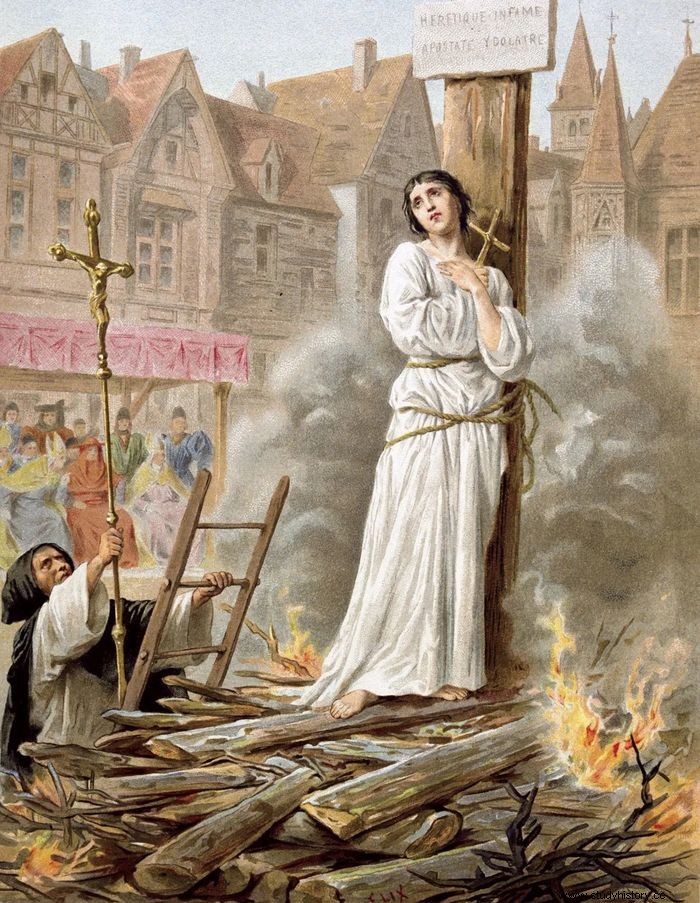
It seemed that there was nothing more that could be done. Then, on May 24, Jeanne d'Arc was released from prison for the first time in four months, and she was taken to the Saint-Ouen cemetery to hear her sentencing. First, one of the theologians forced her to listen to a sermon in which he viciously humiliated King Charles VII. Joan interrupted him because she believed that the theologian had no right to criticize the "good Christian" king and should limit his criticism to her. She requested that all evidence of her words and deeds be sent to Rome after the sermon.
Her judges ignored her request to the pope and began reading out the verdict, leaving her to the mercy of secular authority. When Joan heard this awful announcement, she shouted that she would follow the church's instructions. She received an abortion prepared in advance. She was reluctant to sign it, but did so after being convinced that it was "pleasing to our Lord." Then, according to others, she was sentenced to indefinite imprisonment or imprisonment in a place that is often used as a prison. In any case, the judges made her return to her old prison.
Joan complied with the inquisitor's request to dress as a woman. However, she claimed that she had changed of her own free will and preferred to wear men's clothing when the judges and others visited her two or three days later and saw her once again dressed as a man. She also replied that the voices of St. Catherine of Alexandria and Margaret of Antioch had condemned her "betrayal" when they uttered an abjure in response to their further questions. Because of these concessions, interpreted as evidence of recidivism, the judges and 39 assessors unanimously ruled on May 29 that she had to be handed over to the secular authorities.
The next morning, Cauchon allowed Joan to confess and receive communion - the first for a recurring heretic. She was then escorted to the Place du Vieux-Marché by two Dominicans. Then, in front of her judges and a significant crowd, the verdict that handed her over to the secular arm was read out after she had undergone a new sermon at that place. Eventually she was taken by the executioner, who then led her to the fire and started the fire.
Jeanne d'Arc urged the Dominican to hold up a crucifix so that she could see and shout the assurances of salvation loud enough for her to hear them over the roar of the flames. The Dominican comforted Joan. She insisted until the very end that God had sent her the voices and that she had not been deceived. Few witnesses to her death seem to have questioned her salvation, and they all agreed that she died as a true Christian, according to the 1456 rehabilitation process. A few days later, the English king and the University of Paris solemnly announced the news of the execution. by Joan.
Almost 20 years later, in 1450, Charles VII ordered an investigation of a sample on arrival in Rouen. Cardinal Legate Guillaume d'Estouteville conducted a far more in-depth investigation two years later. Finally, the judgment of 1431 was overturned in 1455 and 1456. It was on the decree of Pope Calixtus III in response to a petition from the family of Jeanne d'Arc. On May 16, 1920, Pope Benedict XV declared Joan a saint; her feast day was May 30th. The French parliament established an annual national celebration in her honor on June 24, 1920, the second Sunday in May.
the conclusion
In general, Joan of Arc's contribution to the history of bravery is greater than her significance in France's political and military history. She has emerged as a representative of French identity that all citizens, regardless of creed or political affiliation, can relate to.
